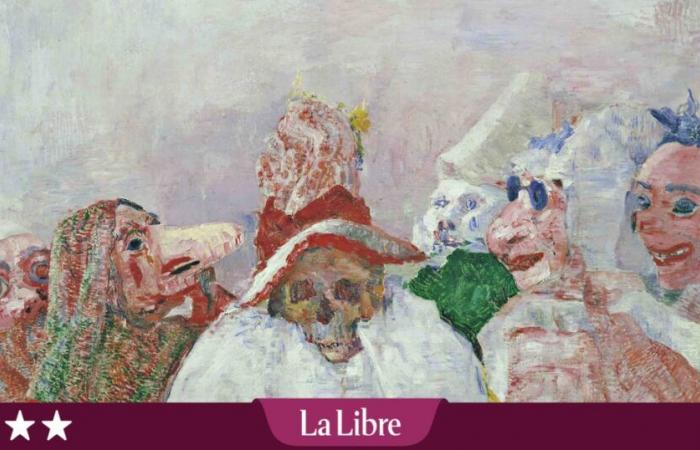The exhibition is not a classic retrospective. It aims to confront Ensor with the greatest of his time (and of the past), to show how he was inspired by them before surpassing them by inventing his Art and expressing his “Whimsical dreams“both announcing the 20th century and recalling Goya and Bosch.
A scenography full of surprises fortunately does not spoil the works which are well showcased. The tour begins with a confrontation between Ensor and the masters of his time whom he knew well as a member of the XX group in Brussels. Three paintings by Manet are hung near an Ensor with a lemon as a link. Verhaeren compared the young Ensor to Manet. The realism of Courbet’s wave rubs shoulders with a seascape by Ensor. Several Claude Monets show how Impressionism brought in light and the outdoors.
Next to it, throne The Oyster Eater (1882) by Ensor, with a subject and size so unacademic. Ensor was only 22 years old, and already had great ambitions, interpreting in his own way the lessons of the Impressionists. We see a bourgeois woman gorging herself (an almost erotic scene) on oysters, surrounded by wines and liqueurs, a symphony of varied whites, lights sparkling in the glasses.
The exhibition also shows a beautiful Starry Night Munch and engravings by Odilon Redon, Félicien Rops and the English painter of natural disasters, John Martin, all of whom shared many of Ensor’s questions.
Adam and Eve cast out
A host of sometimes very crude scenes.
Ensor soon went beyond Impressionism. He had discovered light and devoted all his energy to it. The exhibition in Antwerp shows his hallucinatory paintings of Christ Taming the Storm or some Rebel Angels Struck Down. Canvases dripping with colors and flashes of light. Revolutionary, rebel, he explained: “These are not subjects, they are lights.“His landscapes become”primitive chaos dominated by a divine breath”This light becomes Christ and Christ gradually takes on the figure of Ensor himself, the crucified man in the painting.
The exhibition focuses on Adam and Eve expelled from the earthly paradise in which we can see allusions to Turner, Michelangelo and Rubens.

A nice surprise with a very large, astonishing painting, almost never shown, loaned by the Chicago museum: the “Temptation of Saint Anthony” (1887) a hallucinatory dream composed of about sixty assembled sheets painted and glued on canvas, by Ensor and his aunt (!), with, around the saint and the head of Christ a crowd of sometimes very raw, scabrous scenes, worthy of Bosch. This masterpiece was sold by the Belgians in 2006, as the entry of Christ into Brussels had been let go, for the Getty. A heavy loss for our country.
We then enter the second part of the exhibition titled “Fantasy Dreams” crossing the reconstruction of the entrance to the Cabaret Hell from Paris. Then we come to the famous masks of Ensor. It is compared to those of Emil Nolde and Eugène Laermans, but if for them the mask is a means of concealing the identity of a person, for Ensor on the contrary, it reveals the deep nature of the man who wears it.

We discover all his most famous paintings like Plot but also very rarely shown works like a very beautiful Ensor from 1889 loaned by the Texas Museum: Skeletons wanting to warm up.
This art announces expressionism and dada. Ensor is also in the Belgian vein, satirical, even anarchic, that of the “zwanse”, a form of mocking humor very fashionable at the end of the 19th century.
Brussels inspired Ensor’s revolutionary rage
It should be noted that Herwig Todts includes in the exhibition some works from the years after 1900, often considered less good, but which, here, find their strength of modernity.
“Ensor, fanciful dreams, beyond impressionism”, Museum of Fine Arts Antwerp, KMSKA, until January 19.







